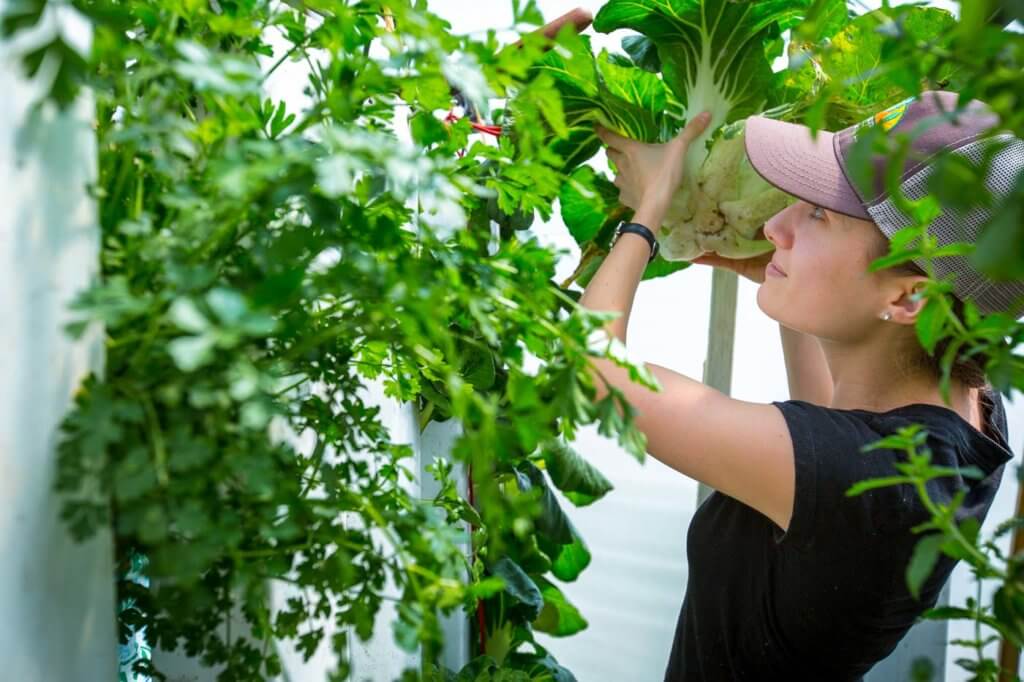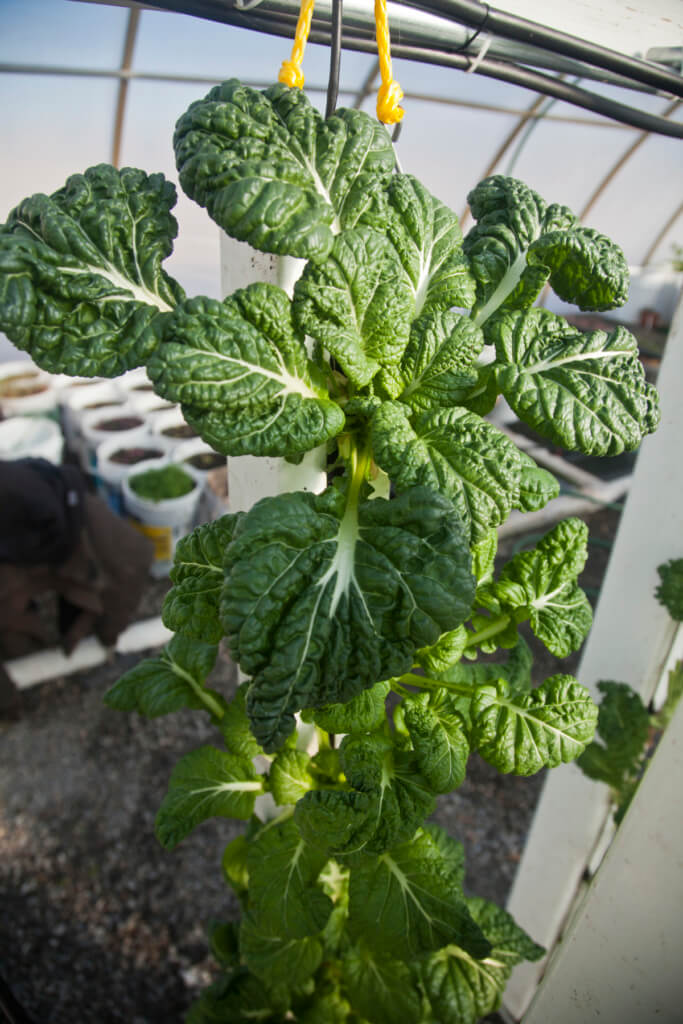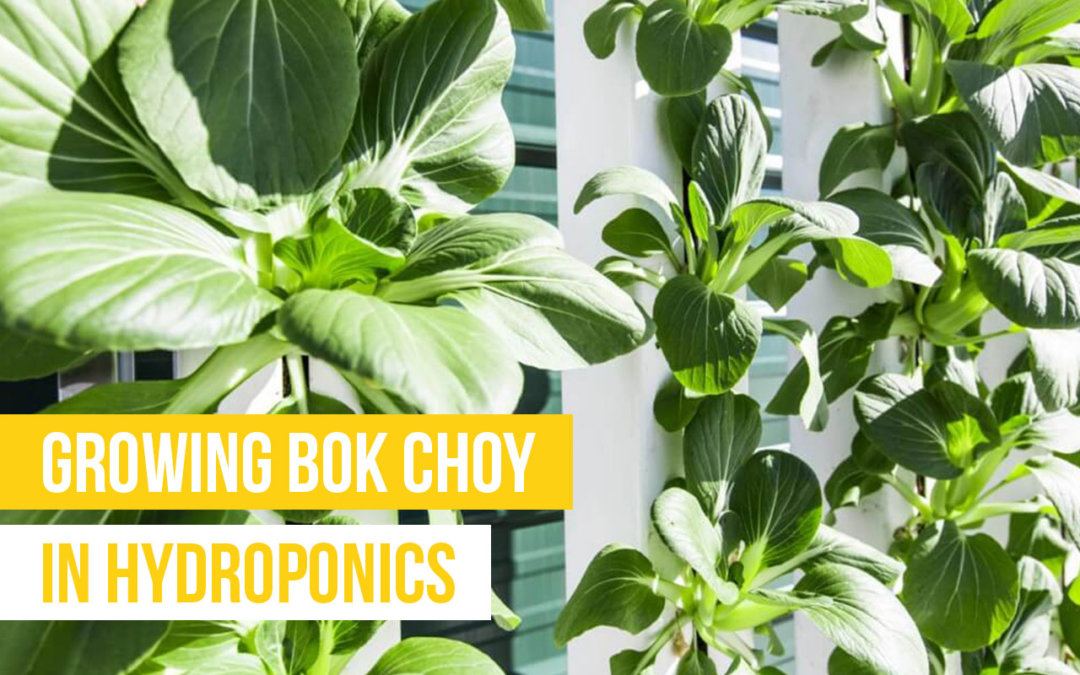Why Bok Choy?
A lot of good food has originated in Asia, and Bok Choy (Brassica campestris, or Pak Choi) is no exception. It’s enjoyed in Asian dishes, salads, and even on burgers for its light, refreshing flavor, and nutritional value; the sweet green offers consumers a significant portion of daily vitamins A, C, and K.
Also called Chinese cabbage, the plant grows on thick sweet stems, often with white veins running through dark leaves. Because of the thick water-heavy leaves, Bok Choy has a high water weight and some varieties can produce as much as 8 pounds per ZipGrow Tower over a 6-week turn. This makes it a great choice for farmers with a market for it.
Varieties and cousins of Bok Choy
Bok Choy comes in a range of sizes, including large varieties like Joi Choi and smaller varieties, like Shanghai Green Pak Choy, which offer more compact, tender heads with delicate flavor.


Tatsoi has longer petioles that Pak Choi but grows in the same conditions.
Bok Choy (Brassica chinensis L.) belongs to a genus in the mustard family called the brassicas. Members of brassica include kale, cabbage, broccoli, cauliflower, and dozens of other important food crops. Perhaps the most similar member of brassica—in terms of appearance and taste—is Tatsoi.
Tatsoi (Brassica narinosa, also called Broadbeak mustard) displays the same thick leaves and light veins as Bok Choy and tastes just as good. Tatsoi can be grown in similar conditions.
Napa cabbage (Brassica rapa Pekinensis) is another brassica member which, while it looks different than Bok Choy and Tatsoi, has the same sweet flavor and crispness, and can be used in many of the same recipes (Napa cabbage is often used for the Korean dish, kimchi). Napa cabbage prefers the pH and EC range of Bok Choy and tastes better when grown in cooler temperatures.
Napa cabbage and Bok Choy are both sometimes called Chinese cabbage and are frequently confused for this reason.
Ideal conditions
- EC: 1.5–2.5
- pH range: 6.0–7.5
- Temperature: 55–75º F (tolerant)
Although Bok Choy is typically milder in cool temperatures, it is fairly temperature tolerant, which makes it an easy fit in many hydroponic and aquaponic systems.
Identifying deficiencies
Deficiencies in Bok Choy can be difficult to identify, as the more “dramatic” symptoms like inter-veinal chlorosis, burning, or bronzing are not common. Deficiencies are marked by stunted growth, cupping, and some yellowing. (See the nutrient deficiency key to identify deficiencies!)
Plant Bok Choy from seed and transplant as soon as there are true leaves on the plant; this will typically occur in about four weeks. Though highest yields occur at six weeks from transplant, Bok Choy may be grown on shorter turns down to four weeks.
Bok Choy has thick but fragile veins and ribs; take care when handling not to break leaves. Store Bok Choy in containers with good air circulation and high relative humidity, at temperatures in the 30s (º F), or just above freezing.
Ready to get growing Bok Choy in hydroponics? Enjoy the Choy!
Once you’ve been successful growing it, try it out in a recipe like this fruity duck breast with Bok Choy and carrots.
Learn more about growing hydroponically
What more information on hydroponics, how it works, and how to run a system? Dive into the Intro to Hydroponics course to learn about types of hydroponic system, management techniques, and crops.




Great article guys.
Which one of the above mentioned varieties has the most nutritional value when eaten?
Dear friend,
I am Le from Vietnam. I found a nutrition solution formular for generic crop on HydroBuddy softwere (detailed as below), but when I used the solution for growing Bok Choy in NFT hydroponic system, these leaves of Bok Choy are curved and abnormal development.
Here is my nutrition solution formular:
Ca(NO3)2.4H20: 67,045g/L
Mg(NO3)2.6H2O: 55,61g/L
Fe-EDTA: 1,54g/L
H3BO3: 0,285g/L
CuSO4.5H2O: 0,02g/L
MnSO4.H2O: 0,155g/L
KH2PO4: 13,18g/L
K2SO4: 42,815g/L
Na2MoO4.2H2O: 0,015g/L
ZnSO4.2H2O: 0,3g/L
Could you please be kind to indicate errors in my nutrition solution formular?
Thank you very much.
Hi Le. Sounds like you have a deficiency – would you send us a few pictures of your plants (to amy@brightagrotech.com) so we can help you identify it?
Any tips on growing thicker stalks and smaller leaves? Seems lots of my plants give energy to giant leaves and the stems are kind of thin.
Hey CE, there are couple things you can try. We list them here: https://university.upstartfarmers.com/blog/4-reasons-you-have-leggy-seedlings 🙂
What nutrients are you using for these babies?
Hi Elaine,
Chemgro lettuce formula (or similar) works great with bok choy and other leafy greens!
Hi, I’m a newbie gardener from Indonesia. I’ve been trying to grow bok choy in my DIY NFT systems (using PVC pipes) several times but never got good enough result. About 1-2 week after transplanting to the system and the plant grew slightly bigger, some leaves turn yellowish and some others even got some kind of burn marks or shriveling. they appear to be stunted too. I’ve already checked the EC and TDS every morning to make sure it meets the requirements but still no significant change happened. Would you please help me to indicate the cause of those problems?
Thanks in advance
Hi Maya—
What are you environmental parameters? Do you have any photos you could send?
Maya did you monitor the ph level and water solution of your NFT? The solution need to hange according to the growth of your plant.
Hi, I have a very similar experience with Lettuce. I transplanted the seedlings in individual jars (kratky method) and slowly the leaves appeared to be burned. I am using SouthernAG 20-20-20 NPK solution. My water is adjusted to 6.25 pH which according to most articles I’ve read is ok. Also, I got the seeds a bit late so I planted them in late April (4/27). I am in So Californnia and the temperature is starting to rise so I kept the jars indoors under growlights (more 6 hours blue and 3 hours blue/red). I am watching them wilt everyday. What could I be doing wrong?
Hello,I’ve been trying to grow bok choy in my dwc systems several times but never got good enough result. after transplanting to the system later some leaves turn yellow have burn marks and shrivel and die.I’ve already checked the EC and ph.please help me to indicate the cause of those problems?
I live in india , south . The temperature here is currently around 28 degrees celcius. Water temp is around 25.
Thanks in advance
can someone help me with the ideal EC values of Bok Choy on a weekly basis